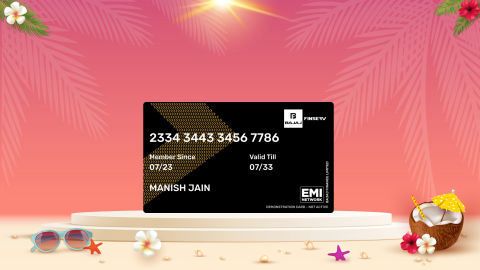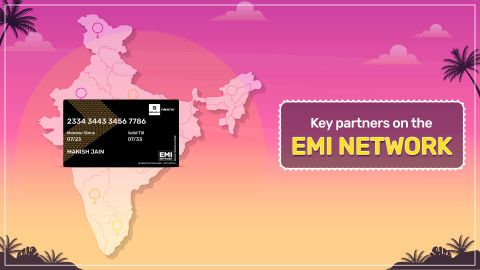Choosing between POLED and AMOLED which is better depends on display quality, durability, and efficiency. While the AMOLED display offers deeper blacks and vivid colours with glass-based panels, POLED display uses plastic substrates for better flexibility and lightweight design. Both technologies enhance viewing experiences, but AMOLED vs POLED differs in longevity and resistance to wear. Understanding their strengths helps in making an informed decision. Explore the latest AMOLED display phones to experience superior visual quality at an affordable price. Learn more on the Bajaj Mall website or visit one of 1.5 lakh+ stores across 4,000+ cities in India. After you select the product based on your requirements, choose a preferred repayment tenure between 3 months to 60 months and shop on Easy EMIs.
POLED vs AMOLED: What is the difference between these OLED technologies
Smartphone displays have advanced significantly, with POLED and AMOLED being two widely used OLED technologies. Both deliver vibrant colours, deep blacks, and energy efficiency, but their core differences lie in construction and flexibility. Understanding these differences helps users decide which display suits their needs better.
Panel structure – POLED uses a plastic substrate instead of the glass found in AMOLED, making it more flexible and lightweight.
Durability – POLED displays are more resistant to drops and impacts due to their plastic material, whereas AMOLED panels may crack easily.
Flexibility – POLED screens can be curved or folded, making them ideal for foldable and edge-display smartphones, unlike AMOLED’s rigid design.
Image quality – AMOLED panels generally provide better brightness and colour accuracy due to advanced manufacturing processes, offering superior visual performance.
Longevity – AMOLED panels tend to last longer as they are less prone to screen degradation compared to POLED.
Cost of production – POLED displays are more cost-effective to manufacture, which allows brands to offer high-quality visuals at a lower price point.
Manufacturers – POLED is mainly used by LG and Motorola, whereas AMOLED is produced by Samsung and found in many flagship devices.
POLED vs AMOLED: Other panel differences
Beyond structural differences, POLED and AMOLED panels vary in areas like power consumption, viewing experience, and overall usability. These factors affect how a display performs under different conditions.
Power efficiency – AMOLED panels use advanced pixel control that turns off unused pixels, consuming less power compared to POLED, which has slightly higher power draw.
Refresh rate capabilities – High-end AMOLED displays can support higher refresh rates for smoother scrolling and gaming, whereas POLED screens may struggle with ultra-high refresh rates.
Brightness levels – AMOLED panels achieve higher peak brightness, making them more visible under direct sunlight, while POLED may appear dimmer outdoors.
Colour accuracy – AMOLED screens are known for deep blacks and rich colour saturation, while POLED panels can sometimes appear slightly muted.
Burn-in risk – Both displays are susceptible to screen burn-in, but POLED has a slightly higher tendency due to plastic materials retaining images longer.
Flexibility for design – POLED’s flexibility allows manufacturers to experiment with unique form factors, whereas AMOLED is commonly used in rigid panels.
Usage in wearables – Many smartwatches and foldable devices prefer POLED for its lightweight and flexible properties, while AMOLED remains dominant in premium smartphones.
Display
The display is one of the most important features of a smartphone. A good display improves your viewing experience with sharp colours and smooth visuals. Phones with AMOLED and pOLED displays provide better brightness, contrast, and refresh rates, making them ideal for watching videos, gaming, and everyday use.
Specification
|
Details
|
Display type
|
AMOLED/pOLED
|
Screen size
|
6.5-inch – 7.6-inch
|
Resolution
|
Full HD+/Quad HD+
|
Refresh rate
|
120 Hz – 144 Hz
|
Brightness
|
Up to 4500 nits
|
Protection
|
Corning Gorilla Glass
|
Also check: Big screen mobile phones
List of Smartphones with pOLED and AMOLED Displays
moto G72
The moto G72 is designed for customers who want a vivid screen and balanced features at an affordable price. Its 120 Hz pOLED display makes watching videos and scrolling smooth, while the 10-bit colour support improves brightness and clarity. The phone also comes with a strong rear camera, good storage, and a reliable battery, making it a dependable option for everyday use.
Specification
|
Details
|
Display (Main)
|
6.6-inch pOLED, 120 Hz
|
Display (External)
|
No
|
Processor
|
MediaTek Helio G99
|
RAM
|
6GB
|
Storage
|
128GB
|
Rear camera
|
108MP + 8MP + 2MP
|
Front camera
|
16MP
|
Battery
|
5,000 mAh
|
Weight
|
166 g
|
Price
|
Rs. 18,999
|
motorola Edge 30
The motorola Edge 30 offers a slim and stylish body with a brilliant pOLED display. Its 144 Hz refresh rate provides extra smooth visuals, perfect for gaming and quick navigation. With a capable Snapdragon processor, this phone runs everyday tasks without lag. Combined with reliable cameras and a lightweight design, it is an ideal choice for those seeking a premium yet affordable smartphone experience.
Specification
|
Details
|
Display (Main)
|
6.7-inch pOLED, 144 Hz
|
Display (External)
|
No
|
Processor
|
Qualcomm Snapdragon 778G+
|
RAM
|
6GB
|
Storage
|
128GB
|
Rear camera
|
50MP + 50MP + 2MP
|
Front camera
|
32MP
|
Battery
|
4,020 mAh
|
Weight
|
155 g
|
Price
|
Rs. 27,999
|
moto G82
The moto G82 is a mid-range smartphone with a sharp pOLED display that improves colour and brightness for daily viewing. It comes with a strong battery and a capable processor for smooth performance. Its triple rear camera system allows for versatile photography, while the lightweight design makes it comfortable to hold. The moto G82 is a balanced phone for practical, everyday users.
Specification
|
Details
|
Display (Main)
|
6.6-inch pOLED, 120 Hz
|
Display (External)
|
No
|
Processor
|
Qualcomm Snapdragon 695
|
RAM
|
6GB
|
Storage
|
128GB
|
Rear camera
|
50MP + 8MP + 2MP
|
Front camera
|
16MP
|
Battery
|
5,000 mAh
|
Weight
|
173 g
|
Price
|
Rs. 21,499
|
motorola Edge 40
The motorola Edge 40 offers a curved pOLED display that looks premium and provides smooth usage with a 144 Hz refresh rate. Its slim body and lightweight design make it comfortable for daily use. Backed by a strong processor, fast charging, and capable cameras, it delivers reliable performance. This smartphone is a good pick for users who want style and dependable features together.
Specification
|
Details
|
Display (Main)
|
6.55-inch curved pOLED, 144 Hz
|
Display (External)
|
No
|
Processor
|
MediaTek Dimensity 8020
|
RAM
|
8GB
|
Storage
|
256GB
|
Rear camera
|
50MP + 13MP
|
Front camera
|
32MP
|
Battery
|
4,400 mAh
|
Weight
|
171 g
|
Price
|
Rs. 29,999
|
motorola Edge 60 Fusion
The motorola Edge 60 Fusion brings a quad-curved pOLED display with rich colour quality and HDR10+ support, giving users a cinematic viewing experience. Its slim design makes it easy to hold, while the strong processor and good camera setup provide reliable performance. With fast charging and solid build quality, this phone is perfect for people who want advanced display features in a modern device.
Specification
|
Details
|
Display (Main)
|
6.7-inch quad-curved pOLED, 144 Hz
|
Display (External)
|
No
|
Processor
|
MediaTek Dimensity 7300
|
RAM
|
8GB
|
Storage
|
256GB
|
Rear camera
|
50MP + 13MP
|
Front camera
|
32MP
|
Battery
|
4,600 mAh
|
Weight
|
178 g
|
Price
|
Rs. 34,999
|
Samsung Galaxy Z Fold 5
The Samsung Galaxy Z Fold 5 is a foldable smartphone that doubles as a compact tablet. Its Dynamic AMOLED display gives rich colours and smooth visuals, making it perfect for entertainment and productivity. With a strong processor, multitasking features, and a premium build, it is built for professionals and tech lovers. The folding design adds convenience and makes it a stylish yet powerful everyday device.
Specification
|
Details
|
Display (Main)
|
7.6-inch Dynamic AMOLED 2X, 120 Hz
|
Display (External)
|
6.2-inch Dynamic AMOLED 2X
|
Processor
|
Qualcomm Snapdragon 8 Gen 2
|
RAM
|
12GB
|
Storage
|
256GB
|
Rear camera
|
50MP + 12MP + 10MP
|
Front camera
|
10MP + 4MP
|
Battery
|
4,400 mAh
|
Weight
|
253 g
|
Price
|
Rs. 1,54,999
|
Samsung Galaxy S24 Ultra
The Samsung Galaxy S24 Ultra is designed for people who want the very best in smartphone technology. Its Dynamic AMOLED display is bright and smooth, perfect for streaming, gaming, and reading. With advanced cameras, long battery life, and strong performance, it delivers a flagship experience. The phone’s durable body and powerful features make it ideal for those who want reliability with style and innovation.
Specification
|
Details
|
Display (Main)
|
6.8-inch Dynamic AMOLED 2X, 120 Hz
|
Display (External)
|
No
|
Processor
|
Qualcomm Snapdragon 8 Gen 3
|
RAM
|
12GB
|
Storage
|
256GB
|
Rear camera
|
200MP + 50MP + 12MP + 10MP
|
Front camera
|
12MP
|
Battery
|
5,000 mAh
|
Weight
|
232 g
|
Price
|
Rs. 1,29,999
|
OnePlus 12
The OnePlus 12 is a premium smartphone built for smooth performance and clear visuals. Its Fluid AMOLED screen provides vibrant colours and fluid scrolling, making it enjoyable for gaming and entertainment. With a capable Snapdragon processor, fast charging, and versatile cameras, the phone offers value to both casual and power users. Its stylish design adds a premium touch while staying practical for daily use.
Specification
|
Details
|
Display (Main)
|
6.82-inch Fluid AMOLED, 120 Hz
|
Display (External)
|
No
|
Processor
|
Qualcomm Snapdragon 8 Gen 3
|
RAM
|
12GB
|
Storage
|
256GB
|
Rear camera
|
50MP + 48MP + 64MP
|
Front camera
|
32MP
|
Battery
|
5,400 mAh
|
Weight
|
220 g
|
Price
|
Rs. 64,999
|
realme 13 Pro Plus
The realme 13 Pro Plus brings modern style with its bright AMOLED screen that makes colours sharp and lively. Built for customers who want smooth usage, it delivers good performance at a fair price. With a decent camera setup, efficient processor, and solid battery, it covers daily needs well. The slim design adds comfort, making it a good choice for everyday smartphone users.
Specification
|
Details
|
Display (Main)
|
6.7-inch AMOLED, 120 Hz
|
Display (External)
|
No
|
Processor
|
Qualcomm Snapdragon 7s Gen 2
|
RAM
|
8GB
|
Storage
|
128GB
|
Rear camera
|
50MP + 8MP + 2MP
|
Front camera
|
32MP
|
Battery
|
5,000 mAh
|
Weight
|
190 g
|
Price
|
Rs. 28,999
|
Redmi Note 14 SE 5G
The Redmi Note 14 SE 5G is a budget-friendly smartphone that comes with a smooth AMOLED display for better viewing quality. It is built to handle regular tasks with ease and offers good value for its price. With a reliable processor, practical camera setup, and long-lasting battery, it is a smart option for users who want modern features without stretching their budget too much.
Specification
|
Details
|
Display (Main)
|
6.6-inch AMOLED, 120 Hz
|
Display (External)
|
No
|
Processor
|
MediaTek Dimensity 6080
|
RAM
|
6GB
|
Storage
|
128GB
|
Rear camera
|
64MP + 2MP
|
Front camera
|
16MP
|
Battery
|
5,000 mAh
|
Weight
|
192 g
|
Price
|
Rs. 16,999
|
Conclusion
Choosing between POLED and AMOLED depends on priorities such as display quality, durability, and flexibility. POLED offers advantages in lightweight design, flexibility, and impact resistance, making it ideal for foldable and curved screens. On the other hand, AMOLED delivers superior brightness, colour accuracy, and power efficiency, making it the preferred choice for flagship smartphones.
AMOLED panels have been refined over time, making them more common in high-end devices, whereas POLED is used in more experimental designs. While both displays provide a great viewing experience, AMOLED generally holds an edge in colour accuracy and longevity, while POLED is better suited for innovative form factors.
Ultimately, the choice comes down to individual needs. Users looking for a premium visual experience with excellent colour reproduction may prefer AMOLED, whereas those interested in durability and flexible design may find POLED more suitable. Both technologies continue to evolve, bringing enhanced displays to modern smartphones and wearable devices.
OLED and AMOLED displays - Price list
Smartphones with pOLED and AMOLED displays are available across different budgets in India. pOLED phones bring curved and premium screen experiences, while AMOLED phones offer bright colours and smooth visuals. Below is a list of popular models with their starting prices, helping you compare options before making the right purchase.
Phone
|
Price
|
moto G72
|
Rs. 18,999
|
motorola Edge 30
|
Rs. 27,999
|
moto G82
|
Rs. 21,499
|
motorola Edge 40
|
Rs. 29,999
|
motorola Edge 60 Fusion
|
Rs. 34,999
|
Samsung Galaxy Z Fold 5
|
Rs. 1,54,999
|
Samsung Galaxy S24 Ultra
|
Rs. 1,29,999
|
OnePlus 12
|
Rs. 64,999
|
realme 13 Pro Plus
|
Rs. 28,999
|
Redmi Note 14 SE 5G
|
Rs. 16,999
|
Additionally, if you are considering buying a new mobile phone or any other electronic device, you can also explore the latest offers from Bajaj Finserv to enjoy exciting deals.
Turn good deals into great ones. Use the Maha Bachat calculator to combine multiple offers and unlock your best possible deals. Calculate your extra savings now!
Shop smart with Easy EMIs
Bajaj Finserv puts you in control of your shopping. See if you are eligible for a loan and get instant approval in just a few steps. Once approved, go to any of 1.5 lakh+ partner stores across India. Pick from over 1 million products from 550+ leading brands. Pay in Easy EMIs with 50+ flexible options that fit your budget. Enjoy a fast, seamless, and stress-free shopping experience—with more freedom and more savings.
Why use the Maha Bachat Savings Calculator
Bajaj Finserv’s Maha Bachat Savings Calculator helps you unlock maximum savings every time you shop at partner stores. It brings together all available brand, dealer, and scheme offers—so you can see your total savings instantly and shop smarter with Easy EMIs.
- Dealer offers - Grab exclusive in-store deals at over 1.5 lakh partner stores across India. Enjoy local discounts and special prices you will not find online.
- Brand offers - Access limited-time discounts from top brands across electronics, appliances, and more. Discover brand-specific savings selected just for you.
- Bajaj offers - Unlock exclusive Bajaj Finserv deals on popular products—available only to our customers. More rewards, more value.
- Scheme offers - Take advantage of time-sensitive offers on select EMI schemes. Get extra benefits after paying just 3 EMIs—visible during EMI selection at checkout.









